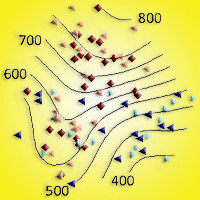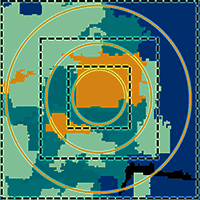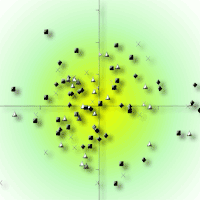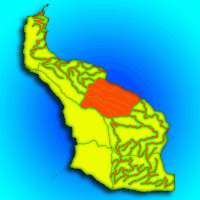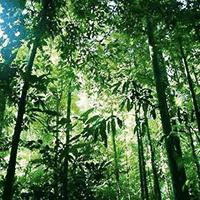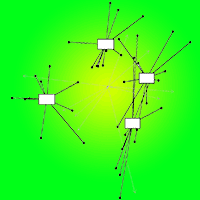Plant functional traits and functional diversity play key roles in ecosystem functioning. Exploring patterns of functional diversity is of great importance in the management process of forest ecosystems. Altitudinal pattern of plant functional diversity is poorly investigated in Hyrcanian relict forest, N Iran. We explored differences in trait composition between lowland and montane forest types. Altitudinal variation of plant functional traits along 2400 m altitudinal gradient was examined. In order to collect species and vegetation data, 67 vegetation sampling plots were placed along the altitudinal gradient. Eight plant functional traits; related to plant physiognomy, competitive ability and dispersal, were selected for 174 recorded vascular plants and weighted by importance-value of taxa. We used generalized linear model, principal coordinate analysis along with functional diversity metrics to investigate functional changes along the gradient. The importance of different traits such as chamaephyte life form, tiny leaves, dry indehiscent fruits and small seeds increase with altitude. In contrast, other traits including large leaves, taller plants, fleshy fruits, anemophily as well as medium to large seeds decrease with increasing elevation. Functional difference between lowland and montane forest vegetation is strongly supported in our results. Trait associations, different environmental parameters, disturbance type and especially altitude were concluded to be important predictors of functional changes. Vegetation type is a key determinant of functional patterns in temperate forests. We strongly recommend exploring and considering functional diversity in forest management practices.
Keywords
, , , ,
Citation
Jafari SM, Zarre S, Alavipanah SK, Ghahremaninejad F (2015). Functional turnover from lowland to montane forests: evidence from the Hyrcanian forest in northern Iran. iForest 8: 359-367. - doi: 10.3832/ifor1002-008
Academic Editor
Giustino Tonon
Paper history
Received: Apr 02, 2013
Accepted: Mar 30, 2014
First online: Sep 16, 2014
Publication Date: Jun 01, 2015
Publication Time: 5.67 months
© SISEF - The Italian Society of Silviculture and Forest Ecology 2015
Open Access
This article is distributed under the terms of the Creative Commons Attribution-Non Commercial 4.0 International (https://creativecommons.org/licenses/by-nc/4.0/), which permits unrestricted use, distribution, and reproduction in any medium, provided you give appropriate credit to the original author(s) and the source, provide a link to the Creative Commons license, and indicate if changes were made.

Breakdown by View Type
(Waiting for server response...)
Article Usage
Total Article Views: 56052
(from publication date up to now)
Breakdown by View Type
HTML Page Views: 46783
Abstract Page Views: 3375
PDF Downloads: 4233
Citation/Reference Downloads: 18
XML Downloads: 1643
Web Metrics
Days since publication: 4105
Overall contacts: 56052
Avg. contacts per week: 95.58
Article Citations
Article citations are based on data periodically collected from the Clarivate Web of Science web site
(last update: Mar 2025)
Total number of cites (since 2015): 7
Average cites per year: 0.64
Publication Metrics
by Dimensions ©
Articles citing this article
List of the papers citing this article based on CrossRef Cited-by.
(1)
Aerts R (1995)The advantages of being evergreen. Trends in Ecology and Evolution 10 (10): 402-407.
CrossRef |
Gscholar
(2)
Akhani H, Djamali M, Ghorbanalizadeh A, Ramezani E (2010)Plant biodiversity of Hyrcanian relict forests, N Iran: an overview of the flora, vegetation, palaeoecology and conservation. Pakistan Journal of Botany 42: 231-258.
Online |
Gscholar
(3)
Anacker B, Rajakaruna N, Ackerly D, Harrison S, Keeley J, Vasey M (2011)Ecological strategies in California chaparral: interacting effects of soils, climate, and fire on specific leaf area. Plant Ecology and Diversity 4 (2-3): 179-188.
CrossRef |
Gscholar
(4)
Assadi M, Massoumi A, Khatamsaz M, Mozaffarian V (1988)Assadi M, Massoumi A, Khatamsaz M, Mozaffarian V (1988) Flora of Iran. Research Institute of Forest and Ranglenads publication, Tehran, Iran, vols 1-70.
Gscholar
(5)
Baker HG (1972)Seed weight in relation to environmental conditions in California. Ecology 53: 997-1010.
CrossRef |
Gscholar
(6)
Bakr EM (2005)A new software for measuring leaf area, and area damaged by
Tetranychus urticae Koch. Journal of Applied Entomology 129: 173-175.
CrossRef |
Gscholar
(7)
Bastl M, Burian M, Kučera J, Prach K, Rektoris L, Štech M (2008)Central European pine bogs change along altitudinal gradient. Preslia 80: 349-363.
Gscholar
(8)
Bolmgren K, Eriksson O (2005)Fleshy fruits, origins, niche shifts and diversification. Oikos 109: 255-272.
CrossRef |
Gscholar
(9)
Braun-Blanquet J (1932)Plant Sociology: the study of plant communities. McGraw-Hill, New York, USA, pp. 439.
Gscholar
(10)
Casanoves F, Di Rienzo JA, Diaz S (2011)FDiversity: a software package for integrated analysis of functional diversity. Methods in Ecology and Evolution 2: 233-237.
CrossRef |
Gscholar
(11)
Clayton WD, Vorontsova MS, Harman KT, Williamson H (2006)GrassBase: the online world grass flora. Web site, Royal Botanical Garden, Kew, UK.
Online |
Gscholar
(12)
Corner EJH (1949)The durian theory or the origin of the modern tree. Annals of Botany 13: 367-414.
Online |
Gscholar
(13)
Cornwell WK, Ackerly DD (2009)Community assembly and shifts in plant trait distributions across an environmental gradient in coastal California. Ecological Monographs 79 (1): 109-126.
CrossRef |
Gscholar
(14)
Dewan ML, Famouri J (1964)The soils of Iran. FAO, Rome, Italy, pp. 319.
Gscholar
(15)
Diaz S, Cabido M (2001)Vive la différence: plant functional diversity matters to ecosystem processes. Trends in Ecology and Evolution 16: 646-655.
CrossRef |
Gscholar
(16)
Diaz S, Cabido M, Casanoves F (1998)Plant functional traits and environmental filters at a regional scale. Journal of Vegetation Science 9 (1): 113-122.
CrossRef |
Gscholar
(17)
Doležal J, Šrutek M (2002)Altitudinal changes in composition and structure of mountain-temperate vegetation: a case study from Western Carpathians. Plant Ecology 158: 201-221.
CrossRef |
Gscholar
(18)
Duckworth JC, Kent M, Ramsay PM (2000)Plant functional types: an alternative to taxonomic plant community description in biogeography? Progress in Physical Geography 24 (4): 515-542.
CrossRef |
Gscholar
(19)
Fischer A, Blaschke M, Bässler C (2011)Altitudinal gradients in biodiversity research: the state of the art and future perspectives under climate change aspects. Waldökologie, Landschaftsforschung und Naturschutz 11: 35-47.
Online |
Gscholar
(20)
Friedman J, Barrett SC (2009)Wind of change: new insights on the ecology and evolution of pollination and mating in wind-pollinated plants. Annals of Botany 103 (9): 1515-1527.
CrossRef |
Gscholar
(21)
Gaston KJ (2000)Global patterns in biodiversity. Nature 405 (6783): 220-227.
CrossRef |
Gscholar
(22)
Gower JC (1966)Some distance properties of latent root and vector methods used in multivariate analysis. Biometrika 53: 325-338.
Online |
Gscholar
(23)
Gower JC (1971)A general coefficient of similarity and some of its properties. Biometrics 27: 623-637.
Online |
Gscholar
(24)
Hammer O, Harper DAT, Ryan PD (2001)PAST- paleontological statistics software package for education and data analysis. Palaeontologia Electronica 4: 1-9.
Online |
Gscholar
(25)
IBM Corp (2011)IBM SPSS Statistics for Windows (version 20.0). New York, USA.
Gscholar
(26)
IRIMO (2012)Online database of meteorological data. Web site, Islamic Republic of Iran Meteorological Organization, Tehran, Iran.
Online |
Gscholar
(27)
Jafari SM, Zarre S, Alavipanah SK (2013)Woody species diversity and forest structure from lowland to montane forest in Hyrcanian forest ecoregion. Journal of Mountain Science 10: 609-620.
CrossRef |
Gscholar
(28)
Khalili A (1973)Precipitation patterns of Central Alburz. Archiv für Meteorologie Geophysik und Bioklimatologie, Serie B 21: 215-232.
CrossRef |
Gscholar
(29)
Kappelle M, Vanuffelen JG, Cleef AM (1995)Altitudinal zonation of montane
Quercus forests along two transects in Chirripo National Park, Costa Rica. Vegetatio 119: 119-153.
Gscholar
(30)
Kleyer M, Bekker RM, Knevel IC, Bakker JP, Thompson K, Sonnenschein M, Poschlod P, van Groenendael JM, Klimeš L, Klimešová J, Klotz S, Rusch GM, Hermy M, Adriaens D, Boedeltje G, Bossuyt B, Dannemann A, Endels P, Götzenberger L, Hodgson JG, Jackel A-K, Kühn I, Kunzmann D, Ozinga WA, Römermann C, Stadler C, Schlegelmilch J, Steendam HJ, Tackenberg O, Wilmann B, Cornelissen JHC, Eriksson O, Garnier E, Peco B (2008)The LEDA Traitbase: a database of life-history traits of the Northwest European flora. Journal of Ecology 6: 1266-1274.
CrossRef |
Gscholar
(31)
Klotz S, Kühn I, Durka W (2002)BIOLFLOR: Eine Datenbank mit biologisch-ökologischen Merkmalen zur Flora von Deutschland [A database of biological-ecological characteristics of the flora of Germany]. Schriftenreihe für Vegetationskunde 38: 1-334. Bundesamt für Naturschutz, Bonn, Germany. [in German]
Online |
Gscholar
(32)
Körner C (1999)Alpine plant life: plant ecology of high mountain ecosystems. Springer-Verlag, Berlin, Germany, pp. 344.
Gscholar
(33)
Körner C (2000)Why are there global gradients in species richness? Mountains might hold the answer. Trends in Ecology and Evolution 15: 513-514.
CrossRef |
Gscholar
(34)
Körner C, Donughue M, Fabbro T, Häuser C, Nogués-Bravo D, Kalin Arroyo MT, Soberon J, Speers L, Spehn EM, Sun H, Tribsch A, Tykarski P, Zbinden N (2007)Creative use of mountain biodiversity databases: the Kazbegi research agenda of GMBA-DIVERSITAS. Mountain Research and Development 27: 276-281.
CrossRef |
Gscholar
(35)
Lavorel S, Garnier E (2002)Predicting changes in community composition and ecosystem functioning from plant traits: revisiting the Holy Grail. Functional Ecology 16: 545-556.
CrossRef |
Gscholar
(36)
Leishman MR, Westoby M (1994)The role of large seed size in shaded conditions, experimental evidence. Functional Ecology 8: 205-214.
CrossRef |
Gscholar
(37)
Leishman MR, Westoby M, Jurado E (1995)Correlates of seed size variation - a comparison among five temperate floras. Journal of Ecology 83: 517-529.
CrossRef |
Gscholar
(38)
Leroy AGS, Arpe K (2007)Glacial refugia for summer-green trees in Europe and south-west Asia as proposed by ECHAM3 time-slice atmospheric model simulations. Journal of Biogeography 34: 2115-2128.
CrossRef |
Gscholar
(39)
Levin DA (1974)The oil content of seeds: an ecological perspective. American Naturalist 108: 193-206.
CrossRef |
Gscholar
(40)
Lord J, Egan J, Clifford T, Jurado E, Leishman M, Williams D, Westoby M (1997)Larger seeds in tropical floras: consistent patterns independent of growth form and dispersal mode. Journal of Biogeography 24: 205-211.
CrossRef |
Gscholar
(41)
Malhado ACM, Whittaker RJ, Malhi Y, Ladle RJ, ter Steege H, Phillips O, Aragão LEOC, Baker TR, Arroyo L, Almeida S, Higuchi N, Killeen TJ, Monteagudo A, Pitman NCA, Prieto A, Salomão RP, Vásquez-Martínez R, Laurance WF, Ramírez-Angulo. H (2010)Are compound leaves an adaptation to seasonal drought or to rapid growth? Evidence from the Amazon rain forest. Global Ecology and Biogeography 19: 852-862.
CrossRef |
Gscholar
(42)
McIntyre S, Lavorel S, Tremont RM (1995)Plant life-history attributes: their relationship to disturbance responses in herbaceous vegetation. Journal of Ecology 83: 31-44.
CrossRef |
Gscholar
(43)
Moles AT, Westoby M (2003)Latitude, seed predation and seed mass. Journal of Biogeography 30: 105-128.
CrossRef |
Gscholar
(44)
Moles AT, Ackerly DD, Tweddle JC, Dickie JB, Smith R, Leishman MR, Mayfield MM, Pitman A, Wood JT, Westoby M (2007)Global patterns in seed size. Global Ecology and Biogeography 16: 109-116.
CrossRef |
Gscholar
(45)
Moles AT, Warton DI, Warman L, Swenson NG, Laffan SW, Zanne AE, Pitman A, Hemmings FA, Leishman MA (2009)Global patterns in plant height. Journal of Ecology 97: 923-932.
CrossRef |
Gscholar
(46)
Pallardy SG (2008)Physiology of woody plants (3rd edn). Academic Press, San Diego, USA, pp. 454.
Gscholar
(47)
Pellissier L, Fournier B, Guisan A, Vittoz P (2010)Plant traits co-vary with altitude in grasslands and forests in the European Alps. Plant Ecology 211: 351-365.
CrossRef |
Gscholar
(48)
Petchy OL, Gaston KJ (2006)Functional diversity: back to basics and looking forward. Ecology Letters 9: 741-758.
CrossRef |
Gscholar
(49)
Pla L, Casanoves F, Di Rienzo J (2012)Quantifying functional diversity. Springer-Verlag, Berlin, Germany, pp. 98.
Online |
Gscholar
(50)
Poorzady M, Bakhtiari F (2009)Spatial and temporal changes of Hyrcanian forest in Iran. iForest 2: 198-206.
CrossRef |
Gscholar
(51)
Rahbek C (1995)The elevational gradient of species richness: a uniform pattern. Ecography 18: 200-205.
CrossRef |
Gscholar
(52)
Rechinger KH (1963)Flora Iranica. Akademische Druck und Verlagsanstal, Graz, Austria, vols. 1-179.
Gscholar
(53)
Royal Botanical Gardens Kew (2008)Seed Information Database (SID) - version 7.1. Web site, Royal Botanical Gardens, Kew, UK.
Online |
Gscholar
(54)
Ryan MG, Yoder BJ (1997)Hydraulic limits to tree height and tree growth: what keeps trees from growing beyond a certain height? Bioscience 47: 235-242.
CrossRef |
Gscholar
(55)
Schmera D, Podani J, Eros T (2009)Measuring the contribution of community members to functional diversity. Oikos 118: 961-971.
CrossRef |
Gscholar
(56)
Sokal RR, Rohlf FG (1995)Biometry (3rd edn). W.H. Freeman and company, New York, USA, pp. 887.
Gscholar
(57)
Straub R (1988)Bodengesellschaften des Vorderen Orients [Soil associations of the Middle East]. Beihefte zum TAVO A 16, Wiesbaden, Germany. [in German]
Gscholar
(58)
Takhtajan A (1986)Floristic regions of the World. University of California Press, Berkeley & Los Angeles, CA, USA, pp. 522.
Gscholar
(59)
Taylor PJ (2005)Unruly complexity: ecology, interpretation, engagement. University of Chicago Press, Chicago, IL, USA, pp. 12.
Online |
Gscholar
(60)
van Ommen Kloeke AEE, Douma JC, Ordonez JC, Reich PB, van Bodegom PM (2011)Global quantification of contrasting leaf life spans strategies for deciduous and evergreen species in response to environmental conditions. Global Ecology and Biogeography 21: 224-235.
CrossRef |
Gscholar
(61)
Whitehead DR (1984)Wind pollination: some ecological and evolutionary perspectives. In: “Pollination Biology” (Real L ed). Academic Press, New York, NY, USA, pp. 97-108.
Gscholar
(62)
Wright IJ, Ackerly DD, Bongers F, Harms KE, Ibarra-Manriquez G, Martinez-Ramos M, Mazer SJ, Muller-Landau HC, Paz H, Pitman NCA (2007)Relationships among ecologically important dimensions of plant trait variations in seven Neotropical forests. Annals of Botany 99: 1003-1015.
CrossRef |
Gscholar



